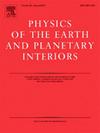电导率异常的频率特性与海岸效应
IF 1.9
3区 地球科学
Q2 GEOCHEMISTRY & GEOPHYSICS
引用次数: 0
摘要
在地壳和上地幔电导率的地球物理研究中,描述电导率异常尺度/强度的定量积分参数几乎尚未被使用。一个简单且信息丰富的参数是总纵向电导G = Q∙ϭi,其中Q为异常体的横截面积,ϭi为异常体的电导。在地球岩石圈中,异常场主要是由导电机制激发的,对此已经发展了一种理论(Rokityansky, 1972;罗基提扬斯基,1975a,罗基提扬斯基,1975b;Rokityansky, 1982)。该理论将G与异常场的频率特性联系起来,或者更具体地说,与周期T0联系起来,在T0处异常场的实部达到最大值,虚部等于0,改变符号。异常场主要由感应箭头表示。本工作的主要目标之一是确定实际地球条件下观测值T0与期望G之间的关系,即确定函数G (T0)。估计G对于以下几个因素很重要:任何额外的参数都增强了研究的可能性。2. 由磁变剖面确定的高度可靠的量G允许将其用作随后计算机解释五分量记录的先验信息。3. 定量特征的可用性允许根据其规模/强度对异常进行排序。该方法于1975年在PEPI中首次描述,但它是基于简化的地球模型,并且获得的相关性G(T0)误差超过半个数量级。本文介绍了新的二维模型的计算结果,该模型尽可能接近典型的地球结构,误差减少了大约三分之一。主要模型为截面紧凑的深层导体和以不同深度的矩形海水层为代表的表层导体,形成海岸效应。在深海(4000米)与大陆架(100公里宽,200米深)的复杂模型中,发现了一个以前未知的现象-陆地沿海地区异常场的非常局部的增加,我们称之为共振协同效应。本文进一步介绍了INTERMAGNET网络处理的137个观测站的结果,首次覆盖了从北冰洋到南极洲的所有纬度。在所有天文台中,分别计算了225、450、900、1800和3000 s周期的诱导箭头。地图上显示了五个感应箭头超过0.8的沿海天文台,以及邻近海域的水深测量图。分析表明,在二维模型上计算的规律解释了用明确的三维测深法在近海观测到的主要行为模式。在两个沿海观测站的数据中发现了共振-协同效应。使用G(T0)方法获得的最基本的结果是,T0大于5000 s的异常(因此G >;2∙109 S∙m)。显然,在地球的岩石圈中不存在这样和更大的导电性。本文章由计算机程序翻译,如有差异,请以英文原文为准。

Frequency characteristics of electrical conductivity anomalies and the coastal effect
In geophysical studies of the electrical conductivity of the Earth's crust and upper mantle, quantitative integral parameters describing the scale/intensity of electrical conductivity anomalies are almost not used yet. A simple and informative parameter is the total lengthwise conductance G = Q∙ϭi, where Q is the cross-section area of the anomalous body and ϭi is its conductivity. In the Earth's lithosphere, anomalous fields are excited/aroused mainly by the conductive mechanism, for which a theory was developed (Rokityansky, 1972; Rokityansky, 1975a, Rokityansky, 1975b; Rokityansky, 1982). This theory links G to the frequency characteristic of the anomalous field or more specifically with the period T0 at which the real part of the anomalous field reaches a maximum and the imaginary part is equal to 0, changing sign. The anomalous field is mainly represented by the induction arrow. One of the main objectives of this work is to specify the relationship between the observed value T0 and the desired G under real Earth conditions, that is, to determine the function G (T0). Estimating G is important for several factors: 1. Any additional parameter enhances a study's possibilities. 2. A highly reliable quantity G determined by magnetic variation profiling allows using it as a priori information for subsequent computer interpretation of 5-component records. 3. The availability of a quantitative characteristic allows ordering anomalies according to their scale/intensity. The method was first described in 1975 in PEPI, but it was based on simplified Earth models, and the dependence G(T0) was obtained with an error exceeding half an order of magnitude. This paper presents results of new 2D models calculations which were as close as possible to typical Earth structures and the error was reduced by approximately three times. The main models were deep conductors with a compact cross-section and surface conductors represented by rectangular seawater layer of varying depths, forming a coastal effect. In a complicated model of the deep (4000 m) sea with the shelf (100 km wide, 200 m deep), a previously unknown phenomenon was discovered - a very local increase in the anomalous field in the coastal zone of land, which we termed the resonance-synergistic effect. The paper further presents results of 137 observatories of the INTERMAGNET network processing, covering for the first time all latitudes from the Arctic Ocean to Antarctica. At all observatories, induction arrows were calculated for periods of 225, 450, 900, 1800 and 3000 s. Five coastal observatories with induction arrows exceeding 0.8 are shown on maps along with the bathymetry of the adjacent seas. The analysis demonstrated that the regularities calculated on 2D models explain the main patterns of behavior observed near the seas with explicit 3D bathymetry. The resonance-synergistic effect was found in the data from two coastal observatories. The most fundamental result obtained using the G(T0) approach is the fact that no anomaly with T0 greater than 5000 s (and consequently G > 2∙109 S∙m) was detected. Apparently, such and greater conductivities are not present in the Earth's lithosphere.
求助全文
通过发布文献求助,成功后即可免费获取论文全文。
去求助
来源期刊

Physics of the Earth and Planetary Interiors
地学天文-地球化学与地球物理
CiteScore
5.00
自引率
4.30%
发文量
78
审稿时长
18.5 weeks
期刊介绍:
Launched in 1968 to fill the need for an international journal in the field of planetary physics, geodesy and geophysics, Physics of the Earth and Planetary Interiors has now grown to become important reading matter for all geophysicists. It is the only journal to be entirely devoted to the physical and chemical processes of planetary interiors.
Original research papers, review articles, short communications and book reviews are all published on a regular basis; and from time to time special issues of the journal are devoted to the publication of the proceedings of symposia and congresses which the editors feel will be of particular interest to the reader.
 求助内容:
求助内容: 应助结果提醒方式:
应助结果提醒方式:


